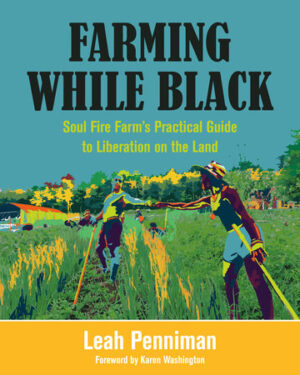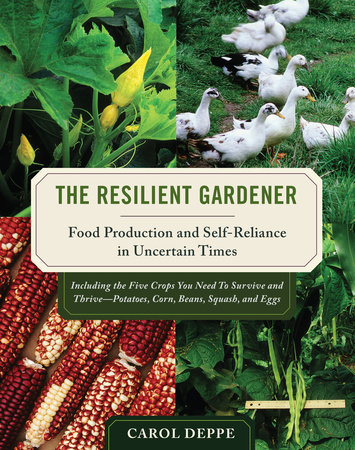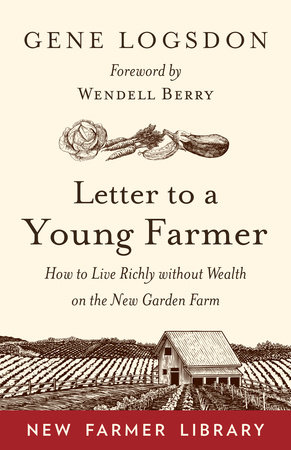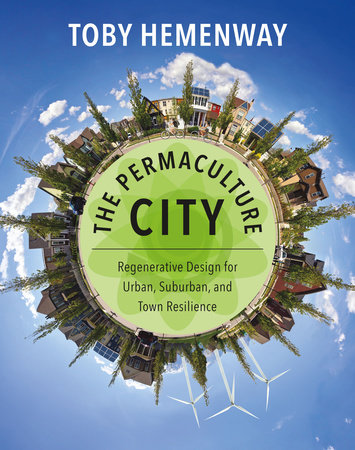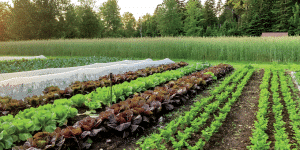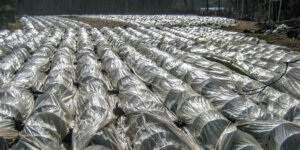How The Great Migration Led to Urban Farming
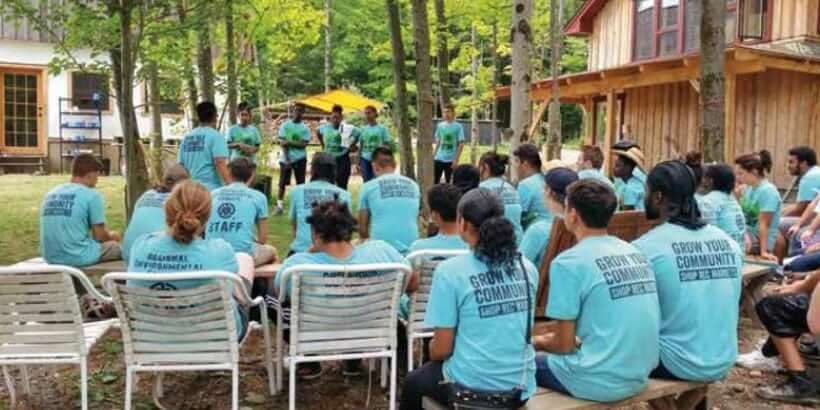
For centuries, humans have been migrating in search of better land, opportunities, and quality of life. For some, those migrations were voluntary while others were forced to move due to far more sinister circumstances. The Great Migration is one such case. During the 1900’s through 1970, over six million black people left the rural south and ventured into the urban north, midwest, and west under the guise of “exploring economic opportunities.” We’ve come to find out, however, that wasn’t quite the case.
The following excerpt is from Farming While Black by Lean Penniman. It has been adapted for the web.
The truth is that the people of the Great Migration were catalyzed to move because of segregation, land theft, racial terrorism, and lynching. Over 4,000 Black people were lynched in the South between 1882 and 1968. At the same time, the United States Department of Agriculture (USDA) was colluding with white supremacist groups to maintain sharecropping by denying independent Black farmers the loans and relief to which we were entitled by law, leading to the loss of millions of acres of Black-owned farmland. By the end of the Great Migration in 1970, 80 percent of African Americans lived in cities. There was a trade-off for leaving the South; as playwright August Wilson wrote, “We were a land-based agrarian people from Africa. We were uprooted from Africa and we spent 200 years developing our culture as black Americans and then we left the South. We uprooted ourselves and attempted to transplant this culture to the pavements of the industrialized North. It was a transplant that didn’t take. I think if we had stayed in the South we would have been a stronger people and because the connection between the South of the 20s, 30s, and 40s has been broken, it’s very difficult to understand who we are.”
In the North, Black people confronted racism in other forms: discrimination in housing, employment, schools, and policing. The National Housing Act of 1934 institutionalized pre-existing housing discrimination. The Federal Housing Administration (FHA) created “residential security maps” that ranked neighborhoods from A to D, listing areas from the most to least desirable for lending. The D neighborhoods were predominantly Black communities and were outlined in red, labeled too risky for mortgage support. These maps were used by public and private lenders to deny mortgages to Black people. Further, the FHA’s Manual of 1936 advocated deed restrictions to “prevent the infiltration of inharmonious racial groups” and to “prohibit the occupancy of properties except by the race for which they are intended.” These recommendations were in the same section that advised how to prevent “nuisances like pig pens.” Redlining led to lower property values, abandonment, vacancy, and decline in Black neighborhoods. When the GI Bill was enacted during World War II, veterans who wanted to buy homes in their own redlined neighborhoods were denied the zero-interest mortgages to which they were entitled. Consequently, white military families moved to the suburbs while Black families had to turn to predatory lenders or rent from slumlords.
In the 1960s and 1970s amid steep urban decline, arson, and blight in our urban neighborhoods, courageous Black and Latinx farmers revived their agricultural traditions by establishing community gardens. Neighbors transformed trash-strewn lots into urban oases with the support of their churches and neighborhood associations. Urban farmers of color removed rubble, planted trees, installed vegetable beds, and built structures for community gatherings. For instance, we pay homage to Hattie Carthan, Black environmental activist, who coordinated the planting of over 1,500 trees in the Bedford-Stuyvesant neighborhood of New York City in the late ’60s and ’70s. We also pay homage to Black growers John and Elizabeth Crews, who catalyzed subsistence farming in Detroit. We pay homage to Rufus and Demalda Newsome, elder leaders in the urban farming movement in Tulsa, and to all the other Black visionaries who helped us find our way home to land.
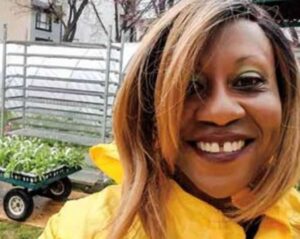
Hattie Carthan was a Black environmental movement pioneer. Her legacy is stewarded by Farmer Yon in BedStuy, New York. Photo courtesy of Yonnette Fleming.
There are now an estimated 18,000 urban community gardens in the US, predominantly in neighborhoods once redlined. Today an overlay GIS map of New York City’s redlined districts and community gardens elegantly correspond. As Black and Brown people worked together to beautify their neighborhoods, city governments and white opportunists began to take an interest. For example, in 1998 Mayor Rudolph Giuliani attempted to put over 700 community gardens up for sale and was only stopped because of powerful grassroots resistance through the courts and civil disobedience. Under the guise of color-blindness, public and private sectors have facilitated gentrification, promoting a vision of low-income communities as the “urban frontier,” encouraging young, middle-class white people to act as urban “pioneers” and “homesteaders” by populating these communities building by building, block by block. These white “pioneers” have co-opted urban farming in many locations, attracting grants, media attention, and public influence denied to the Black founders of the movement.
For most of our community, the city is now home and we need to find our “liberation on land” amid the pavement. Through our own experiences, we’ve identified a few strategies to help others navigate how to access land, rooftops, and sunny corners in urban spaces and offer ideas for managing farming challenges specific to urban areas, including small growing area, contaminated water, insecure land tenure, and community support.
Laws and Land Access
For a few years, our illegal chickens flew under the radar of the city. Albany had an ordinance that disallowed chickens and other livestock under the belief that they were “incompatible with urban life.” There was an exception for educational nonprofits, but no flexibility for residents trying to raise food for survival. We collaborated with three other neighbors with adjoining backyards to take down our fences and build a collaborative food landscape. All combined, there were two chicken coops, a goat pen, vegetable gardens, and mulberry trees. Our young children could roam far without ever having to cross a street. Unfortunately, code enforcement caught on and evicted the chickens. Many neighbors took the fight to city hall. After nine months of organizing, activists convinced the city council to allow backyard chickens in 2011. Sadly, the mayor vetoed the vote and the chickens could not return.
In many cities, these nuisance ordinances were created to specifically target immigrants and people of color who were more likely to be preserving agrarian practices. Whether you decide to abide by the law, skirt the law, or challenge the law, it is helpful to understand what restrictions apply to urban agriculture in your area. Before you invest substantial resources into your plot of earth, investigate the following questions:
Zoning. Does the zoning of the land permit agriculture? What “public nuisance” laws exist in your city? Are there “right to farm” laws in your county?
Greenhouses and high tunnels. Is a building permit required for greenhouses? Is there a size limitation? Note that some states categorize greenhouses as permanent structures and high tunnels as temporary structures, influencing how they are taxed.
Animal housing. Is animal agriculture permitted? Is a building permit required for chicken coops and other animal housing? How far away must animals live from residential buildings or property lines?
Rooftop and wall gardens. What building code requirements exist for a rooftop garden? Do rooftop gardens require permits? Is a permit required to grow plants on the exterior wall of a building?
Food safety. Is it legal to sell processed food out of your home kitchen per a “cottage food law”? If not, determine whether a commercial kitchen is available to rent. Learn more about food safety law from the Urban Agricultural Legal Resource Library, a project of the Sustainable Economies Law Center.
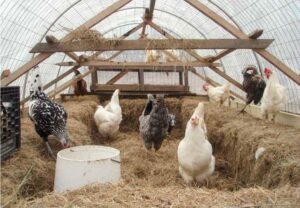
A small flock of hens is compatible with urban life.
Should you decide to advocate for changes in zoning or ordinances that are more favorable to urban agriculture, it helps to look at best practices in other cities. For example, Cleveland, Ohio, has an Urban Garden District Zoning ordinance that gives community gardens additional protection from being sold and converted to other uses. Seattle, Richmond, Portland, Oakland, Minneapolis, Milwaukee, Chicago, and Baltimore also have useful policy templates for promoting urban agriculture. In advocating for policy change, try to get your hands on any community food assessments that can provide data to support the need to uplift urban agriculture. Engage with the local food policy council to find allies for your cause.
Lack of accessible and affordable land can be one of the greatest constraints to urban farming. Empty lots, utility rights-of-way, private backyards, parks, institutional land (schools, hospitals, churches, prisons, universities, senior homes), and rooftops are all examples of vacant land that might be reclaimed for agricultural use. When you encounter vacant land with agricultural potential, take note of the address of the adjacent parcels and take that information to the local tax assessor or department of finance. Ask to see the tax map and property records to determine the parcel number, and research the site’s ownership history. You can then contact the most recent owner to discuss license, lease, or sale of the property. Alternatively, many cities have passed legislation to allow citizen-controlled land banks and land trusts to manage vacant land. If your city has a land bank, approach them directly to determine what properties are available, their land-use history, zoning designation, and any public programs that provide incentives for their purchase. The national nonprofit Trust for Public Land also stewards urban lots that can be used for agriculture.
If you are unable to buy property outright, you will need to enter into a lease or other contractual agreement to guarantee access to the land. The Urban Agricultural Legal Resource Library outlines important elements of land-use agreements for both public and private land and sample land-use agreements. Your land-use agreement should include the following provisions, at a minimum:
Provisions of Land-Use Agreement
Land. Specifications of size and location.
Rent. Cost to tenant. Use of land. Specification of permitted uses and prohibited uses (sales, tree removal, fires, and the like).
Term. Duration of lease, options for lease renewal, and expected tenure of project on land.
Building and improvements. Clarification of building types prohibited and permitted (carports, storage, temporary shelters, and so on) and improvements (fencing, garden beds, landscaping).
Right of entry. For example, restrictions to farm employees, contract workers, volunteers.
Hours of use. Days and times of activities, clarification of overnight stay.
Noise. Expected decibels of noise pollution created.
Animals. Use of animals and restrictions thereof.
Expected traffic. Estimated number of trips to the site and number of people expected on a plot at any given time.
Growing practices. Farmers’ use of tools/machinery and use of pesticides, fertilizer, fungicides, and so on. (On the city’s end, this could be a selection criterion—for example, projects growing organically could rank higher than projects proposing to use these chemicals.)
Environmental impacts. Management of runoff and water pollution.
Water usage. Agreement on source, use, and payment.
Routine maintenance. Specifies responsibilities of landowner and farmer in maintenance of plot’s appearance and preventing hazards.
Subleasing policy. Permitted/prohibited and where liability for subtenant lies.
Garden produce. Clarification of ownership of produce from the land and whether sales are permitted.
Compost. Agreement on use and location of compost pile and perhaps use of landowner’s acceptable yard and kitchen wastes.
Payment. Type and amount of payment; can be monetary or in-kind through share of crops.
Liability. Two-way release of liability; each party gives indemnity to the other over specific scenarios and legal responsibilities for their respective uses of the land.
Recommended Reads
Lessons in Resilience: How to Plan a Successful Farm Business
Recent Articles
No heated greenhouse? No problem! Discover the secrets to thriving winter gardening without breaking the bank.
Read MoreWintergreen is the stunning evergreen groundcover that’s a game-changer for your garden! It’s cherished for its aromatic leaves, vibrant fall color & bright berries.
Read MoreYear-round growth without the hefty price tag of a greenhouse? Low tunnels are the cost-effective and flexible solution you’ve been looking for. Grow year-round with low tunnels!
Read MoreGrow winter carrots for a sweeter & more flavorful harvest! Ditch the bland, store-bought carrots this winter! Grow your own winter carrots for a sweeter and more flavorful twist 🥕🥕
Read More

